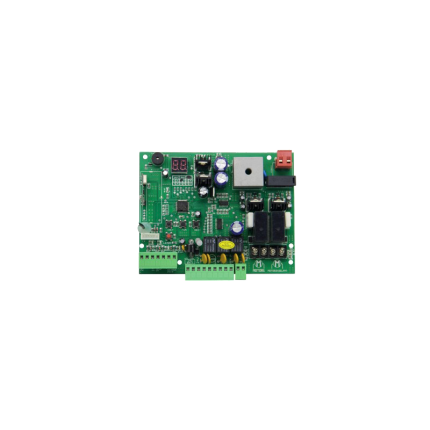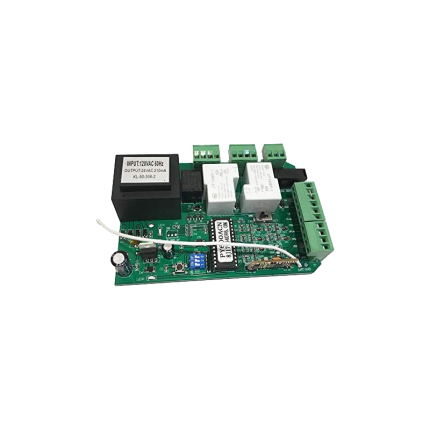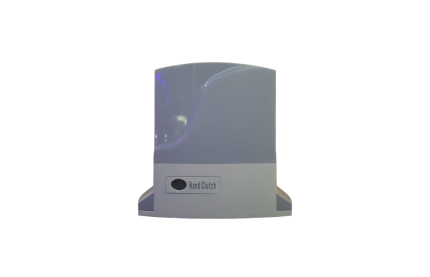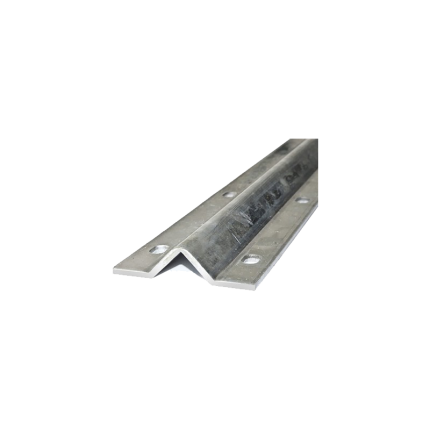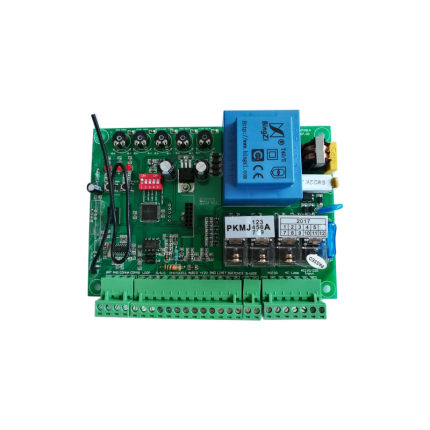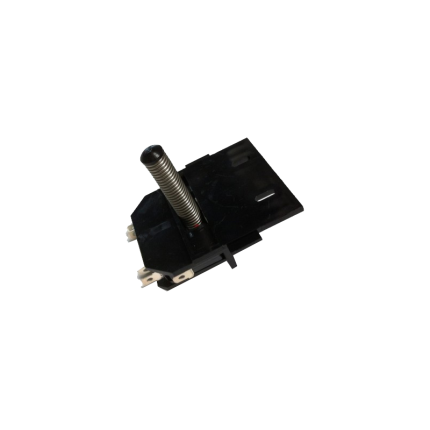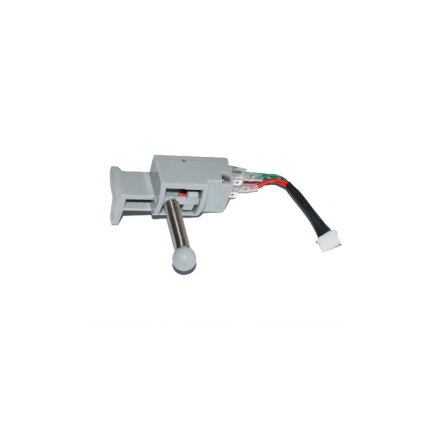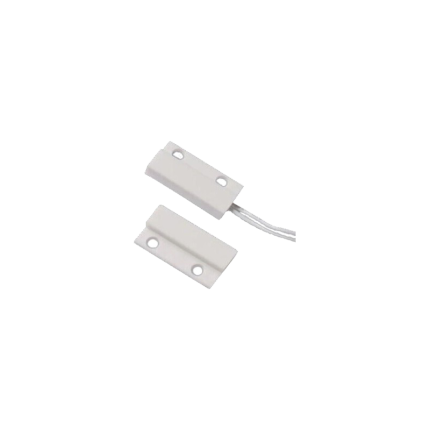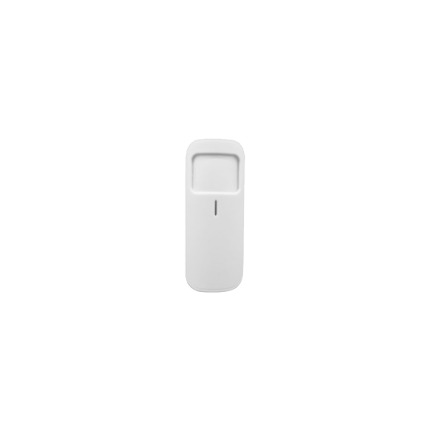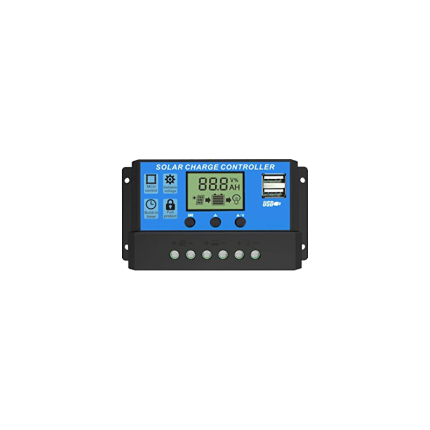Shop
Swing gate operator control board SWRG24
Ship or pick up from our office.
Swing gate operator control board SWRG24
The SWRG24 is a universal 24V DC main control board for swing gate operators. This means it's designed to be adaptable and compatible with a wide variety of 24-volt direct current swing gate systems, rather than being specific to one brand or model. Here's a breakdown of its key features and functionalities: Key Features- 24V DC Operation: The SWRG24 operates on a 24-volt direct current power supply, which is common in many modern gate systems, especially those that might incorporate battery backup for operation during power outages.
- Universal Compatibility: It's designed to work with various swing gate openers and systems, offering versatility for different installations. This often means it can replace a damaged board in an existing system or be used as the control center for a custom gate setup.
- Programmable and Adjustable Settings: The board is fully programmable, allowing installers and users to customize various operational parameters. These often include:
- Resistance Sensitivity: Adjusts how much force the gate encounters before stopping or reversing, crucial for safety.
- Motor Working Time: Sets the maximum time the motor will run for opening or closing, preventing over-rotation or damage.
- Auto-Closing Time: Configures a delay after opening before the gate automatically closes, enhancing convenience and security.
- Motor Output Power: Allows for fine-tuning the motor's strength to suit the gate's weight and size.
- Soft Start/Stop: This feature typically provides a gradual acceleration and deceleration of the gate, reducing wear and tear on the motor and hardware, and providing smoother operation.
- Quick Close/Anti-Tailgate: Some models may include features to close the gate immediately after a vehicle passes, preventing unauthorized vehicles from following closely behind.
- Digital Display: Many SWRG24 boards feature a digital display (often a digital tube display), which simplifies the process of adjusting settings, troubleshooting, and monitoring the system's status.
- Compatibility with Accessories: It typically has terminals and inputs for connecting a range of safety and access control devices, such as:
- Photocells/Infrared Sensors: Essential safety devices that detect obstructions in the gate's path and prevent it from closing on people or objects.
- Loop Detectors: Used to detect vehicles approaching or exiting the gate, triggering opening or closing.
- Push Buttons/Keypads: For manual operation or coded access.
- Remote Controls: For wireless operation.
- Warning Lights/Alarms: For signaling gate movement or entrapment.
- Safety Compliance: Modern gate control boards like the SWRG24 are often designed to comply with safety standards like UL325, which requires the use of entrapment protection devices.
- Potential for Battery Backup: As a 24V DC system, it's often designed to integrate with battery backup systems, ensuring continued operation during power outages.
- Residential Gates: For homeowners seeking automated access and enhanced security.
- Commercial and Industrial Gates: For businesses and facilities with higher traffic demands, where reliable and secure access is critical.
Sliding gate operator control board SLRG110
Ship or pick up from our office.
Sliding gate operator control board SLRG110
The SLRG110 is a universal main control board for sliding gate operators that runs on 110-volt AC power.
It acts as the "brain" of a sliding gate system, managing its core functions.
Here's a breakdown of what the SLRG110 offers:
Core Functionality
- Motor Control: It receives signals from various access devices (like remote controls or keypads) and translates them into commands to control the gate's motor, initiating opening, closing, and stopping movements.
- Power Management: It receives power from a 110V AC source and directs it to the gate motor and other connected accessories.
- Adjustable Settings: The board typically allows for customization of gate operation, including:
- Adjustable speed settings for both opening and closing.
- Adjustable auto-close timer (e.g., 0, 30, 60, 90 seconds).
- Adjustable torque and closing force to suit different gate weights and preferences.
- Ability to add and delete remote controls easily.
- Option to set auto-close when power is restored after an outage.
Key Features & Safety
- Obstruction Detection: A crucial safety feature, the SLRG110 can detect obstructions in the gate's path during movement and automatically stop or reverse the gate to prevent damage or injury.
- This often utilizes infrared detection connectors for photocells.
- Remote Control Capability: It's designed to work seamlessly with remote controls for convenient operation.
- Emergency Release: The system usually includes an emergency release key for manual operation in case of power failure.
- Limit Switches: It connects to limit switches (often magnetic) that define the gate's fully open and closed positions, preventing overtravel.
- Accessory Inputs: The board has various input terminals for connecting additional accessories like:
- Photocells (safety beams)
- Manual push buttons
- Wired keypads
- GSM inputs (for remote access via mobile networks)
- Vehicle sensor exit wands
Universal Compatibility
The SLRG110 is considered a universal control board, meaning it's designed to be compatible with a wide range of sliding gate opener models.
This makes it a versatile replacement option for existing systems. It can operate gates weighing up to approximately 1750-1760 lbs.
Sliding gate opener -Royalgate RGSL0.5TN24
Ship or pick up from our office.
Sliding gate opener -Royalgate RGSL0.5TN24
*Suitable gate weight: Maximum 500 Kg Included: *1 x DC 24 Volts Electromechanical motor *1 x Main control board *4 Meters x SLGR41 Gear rack *2 x Remote control *2 x Manual release key The Royalgate RGSL0.5TN24 is a sliding gate opener designed for automated operation of sliding gates. Here's a breakdown of its key features and specifications based on the information available:- Type: Sliding Gate Opener. This means it's for gates that move horizontally along a track, not swinging gates.
- Capacity: It's designed to handle gates with a maximum weight of 500 kg (approximately 1100 lbs).
- Motor: It's powered by a 24V DC electromechanical motor. DC motors are known for energy efficiency and are often suitable for battery backup and solar power options.
- Key Features:
- Automated Operation: Provides convenient opening and closing of your sliding gate.
- Emergency Release: Includes manual release keys for operation during power failures.
- Safety Mechanisms: Often includes features like soft start/stop (to reduce wear and tear) and auto-reverse (the gate reverses if it detects an obstruction).
- Adjustable Auto-Close: The system likely has a built-in timer for automatic closing of the gate (e.g., 0, 30, 60, 90 seconds).
- Reliable Limit Sensors: Uses spring limit sensors for easy adjustment of the gate's open and close positions.
- Expandability: Can be integrated with optional accessories such as keypads, additional remote controls, radio receivers, and safety sensors (like photocells).
- Applications: Commonly used for both residential and light commercial applications, such as driveways, parking areas, and small commercial properties.
- Construction: The control unit often features an air-stop seal against moisture and insects, and mechanical parts are typically lubricated with lithium grease for protection against corrosion.
Sliding Gate V-Track
Ship or pick up from our office.
Sliding Gate V-Track
NOTE: For 25 ft sliding gate V-Track, please do not make an online order.Because of the limit of the shipping length and weight, we have to cut the full length of the product (25') to 2 x (12'-6") for pick-up from our store OR 4 x (6'-3") to send by Canada Post.
If your order requires cutting services, additional costs will apply.
To create an order for sliding gate V-Track, please send your request with the shipping address, postal code, and the length of your inquiry in the note. You will receive a quotation with the shipping costs within a maximum of one business day. A sliding gate V-track is a specific type of ground track that a sliding gate rolls on, utilizing wheels with a complementary V-shaped groove. This system is one of the most common ways to implement a sliding driveway gate, especially for residential and light commercial applications. Here's a breakdown: Purpose: The sliding gate V-track as the linear guide and support for the entire sliding gate. It ensures that the gate moves in a straight line, smoothly, and without wobbling or derailing as it opens and closes. It's an integral part of a "rolling gate" system, where the gate literally rolls on the ground. Key Characteristics and Components:- V-Shape Profile: The most defining feature. The track has an inverted V-shape or a 90-degree angle (like an angle iron) with a slightly rounded top. This V-shape mates perfectly with the V-groove wheels attached to the bottom of the gate.
- Materials:
- Galvanized Steel (Most Common): Highly durable, strong, and resistant to corrosion due to the galvanization process. It can handle heavy gates and high traffic volumes. Sections are typically joined together to form the required length.
- Aluminum: Lighter weight and excellent corrosion resistance. Often used for lighter gates or in environments where rust is a major concern (like coastal areas).
- Installation:
- Bolt-Down: The V-track is typically designed to be bolted securely to a concrete driveway or foundation. It has pre-drilled holes for anchor bolts. This allows for easier installation on existing concrete and simpler replacement if a section gets damaged.
- Embeddable (Less Common for DIY): Some V-tracks are designed to be embedded directly into wet concrete during construction.
- Level and Straight: Crucially, the V-track must be installed perfectly level and straight along the entire travel path of the gate to ensure smooth and consistent operation. Any dips, humps, or curves will cause issues with the gate's movement and can put undue strain on the gate operator and wheels.
- Lengths: Sliding gate V-tracks are sold in sections (e.g., 6 feet, 10 feet, 2.4 meters, 3 meters). Multiple sections are joined together using connection pins or by welding to achieve the total required length, which should be at least twice the width of the gate opening to allow the gate to fully retract.
- Complementary Hardware:
- V-Groove Wheels: These are essential and roll directly on top of the V-track. As discussed previously, they have a V-shaped groove that fits snugly into the track.
- Guide Rollers/Posts: Used at the top of the gate to keep it upright and prevent tipping.
- Gate Stops: Installed at the ends of the track to prevent the gate from over-traveling.
- Stability: The sliding gate V-track V-groove design provides excellent lateral stability, keeping the gate aligned and preventing it from wobbling.
- Load Capacity: Due to the direct ground support and robust V-track/wheel combination, these systems can handle very heavy and long gates.
- Simple Mechanical Principle: The system is straightforward, making it reliable.
- Debris Accumulation: The main drawback is that the V-track, being on the ground, is susceptible to collecting dirt, leaves, gravel, snow, and ice. This debris can obstruct the gate's movement, cause wear on the wheels, and may even lead to derailment or damage to the gate opener. Regular cleaning of the track is essential, especially during winter months in Canada.
- Driveway Disruption: Installing a sliding gate V-track requires modifying the driveway surface, often by bolting it down or embedding it in concrete, which creates a slight raised profile.
- Water Drainage: Proper drainage around the track is important to prevent water pooling.
Universal sliding gate operator control board SLRG24
Ship or pick up from our office.
Universal sliding gate operator control board SLRG24
The Universal Sliding Gate Operator Control Board SLRG24 is the "brain" of an automatic sliding gate system. It's designed to be a versatile replacement or core component for various DC-powered sliding gate operators, meaning it can control a wide range of motors and integrate with different accessories. Here's a detailed look at its features and significance: Core Function of a Control Board: The control board is the central electronic unit that:- Receives Signals: Interprets commands from remote controls, keypads, safety sensors (photocells, shock sensors, loop detectors), intercom systems, and other access control devices.
- Processes Logic: Decides what action the gate should take based on the received signals and its programmed settings (e.g., open fully, partially open for pedestrian, close, stop, reverse due to obstruction).
- Activates Motor: Sends the appropriate electrical signals to the gate motor to start, stop, or reverse its movement.
- Manages Accessories: Controls the power and operation of connected safety and convenience accessories like flashing lights, electric locks, and alarm outputs.
- Universal Compatibility: This is its defining characteristic.
- DC Motor Compatibility: It's designed to work with both DC 12V and DC 24V motors. This flexibility is crucial as many sliding gate operators use one of these DC voltages. It's important to note that it is NOT compatible with AC (Alternating Current) motors (like 110V or 220V AC motors).
- Limit Switch Flexibility: It can work with both spring-type mechanical limit switches and magnetic limit switches. This is a significant advantage for a universal board, as it means it can be used with a wider range of existing gate operators.
- Input Power: The board itself typically requires an AC 24V input power. This means it likely has an internal transformer or is designed to be powered by an external AC 24V transformer.
- Full Programmability: Offers a wide range of adjustable parameters, allowing customization of gate operation to suit specific needs:
- Gate Speed: Adjustment of how fast the gate opens and closes.
- Opening/Closing Times: Setting precise durations for gate cycles.
- Automatic Closing Time: Programming a delay before the gate automatically closes after opening (e.g., 15, 30, 45 seconds, or up to 3 minutes).
- Safety Settings: Integration and management of safety sensors (photocells, obstacle detection sensitivity).
- Pedestrian Mode: Ability to set a partial opening for pedestrian access.
- Party Mode: Often allows for temporary cancellation of auto-close for periods when many visitors are expected.
- Remote Control Capability:
- Features an integrated radio receiver, typically operating at 433.92MHz with rolling code technology. Rolling code prevents unauthorized cloning of remote controls, enhancing security.
- Supports multiple remote controls (e.g., up to 20 or more), making it suitable for larger families or multi-user environments.
- Accessory Output Power: Provides DC 24V accessory output power (e.g., 200mA max) to power various external devices:
- Safety Sensors (Photocells): Connects to and powers safety beams.
- Warning Flash Lights: Powers a flashing beacon that activates when the gate is in motion.
- Keypads/Intercom Systems: Provides power and input connections for wired access control devices.
- Electric Locks: Can manage the operation of an electric lock for added security.
- Safety Mechanisms:
- Obstacle Detection: Uses current sensing or other methods to detect if the gate encounters an obstruction during movement. Upon detection, it will typically stop or reverse the gate for safety.
- Automatic Stop Function: Ensures the gate stops precisely at its programmed limits.
- Short Circuit Protection: Often includes protection for output circuits (e.g., lock output) to prevent damage from wiring faults.
- Solar System Input: The mention of "Input Solar system" suggests it's designed to be compatible with or directly connect to solar charging systems for off-grid gate installations, making it suitable for rural properties or areas without easy access to AC power.
- Installation and Durability:
- Designed for relatively easy installation.
- Built with robust components for long-lasting performance in various weather conditions, though it usually requires housing in a waterproof box (often included in a kit).
- Features an automatic power-off memory function, retaining settings after a power outage.
- Replacing a Faulty Board: If an existing 12V or 24V DC sliding gate operator has a non-functional control board, the SLRG24 could be a suitable and cost-effective replacement, reducing the need to replace the entire gate motor.
- New Custom Gate Systems: It provides a flexible "brain" for custom-built sliding gate systems where the motor and other components are chosen separately.
- Solar-Powered Gates: Its solar input capability is a definite advantage for properties in Surrey or surrounding areas that might prefer or require solar power for their gate.
Warning Flash Light
Ship or pick up from our office.
Warning Flash Light
A driveway gate warning flash light (also commonly called a flashing beacon or safety light) is a safety accessory for automatic driveway gates. Its primary purpose is to provide a clear visual signal to pedestrians, cyclists, and vehicles that the gate is in motion (opening or closing) or about to move. Why are they important? Automatic gates, especially large or fast-moving ones, can pose a safety hazard if their movement isn't clearly indicated. A warning flash light enhances safety by:- Alerting Pedestrians: People walking or cycling near the gate might not hear the gate opener motor, especially if there's ambient noise. A flashing light provides an immediate visual cue that the gate is active, encouraging them to stay clear.
- Warning Vehicles: Drivers approaching the driveway might not immediately notice a gate beginning to open or close, especially at night or in adverse weather conditions. The flashing light draws their attention to the gate's movement, preventing potential collisions.
- Visibility in Poor Conditions: In fog, rain, snow, or at night (all relevant for Surrey, BC's climate), the flashing light significantly improves the gate's visibility.
- Compliance with Safety Standards: While not always legally mandated for residential gates, many gate automation safety standards (and good practice) recommend or require warning lights, particularly for commercial or high-traffic gates. Installing one helps ensure a safer operation.
- Feedback to the User: For the gate owner, the flashing light also provides a visual confirmation that the gate has received the command and is indeed operating.
- Flashing Action: The light typically flashes intermittently (strobes) to maximize its attention-grabbing effect.
- Color: Most commonly amber (orange/yellow) or red, as these colors are universally recognized as warning signals.
- Power Source: Designed to be wired into the gate operator's control board. They typically operate on low voltage (e.g., 12V, 24V DC, or sometimes universal 12-265V AC/DC) provided by the gate opener's power supply.
- LED vs. Incandescent: Modern warning lights almost exclusively use LEDs (Light Emitting Diodes) because they are:
- More energy-efficient.
- Have a much longer lifespan.
- Are brighter and more visible than traditional incandescent bulbs.
- Weatherproof: As they are mounted outdoors, they are built to be weatherproof (e.g., IP54, IP65, or IP67 rated) to withstand rain, dust, and temperature variations.
- Integrated Antenna (Optional but common): Many modern warning lights include a built-in antenna for the gate's radio receiver. This can extend the range of remote controls, which is a practical dual function, especially for long driveways.
- Mounting: Designed for easy mounting on a post, wall, or the gate opener's column.
- Audible Alerts (Optional): Some advanced models may also include a small buzzer or chime to provide an audible warning in addition to the visual flash.
Sliding gate operator limit sensor -Spring
Ship or pick up from our office.
Sliding gate operator limit sensor -Spring
A sliding gate operator limit sensor with a spring mechanism (also known as a mechanical limit switch or spring limit switch) is a common type of sensor used in automatic sliding gate systems to define the gate's fully open and fully closed positions. Here's how it works and what its characteristics are: Purpose of a Limit Sensor: For any automatic gate operator, the system needs to know exactly when the gate has reached its desired open and closed positions. This is crucial for:- Stopping the Motor: Preventing the motor from continuing to run once the gate has reached its limit, which would otherwise cause damage to the gate, the motor, or the track.
- Safety: Ensuring the gate stops precisely where it should, preventing it from hitting obstacles or over-extending.
- Proper Operation: Allowing for features like auto-closing, pedestrian mode, and proper synchronization if it's a dual-gate system.
- Components: A spring limit switch typically consists of:
- A microswitch (an electrical switch that requires very little force to operate).
- A spring-loaded lever, arm, or plunger connected to the microswitch.
- A mounting bracket to attach it to the gate operator or gate frame.
- Mounting: The spring limit switch is usually positioned on the gate operator itself, or on a bracket near the motor.
- Interaction with the Gate:
- On the sliding gate itself, usually along the gear rack or a specific part of the gate frame, two small "stop" tabs or flags are installed – one for the open limit and one for the close limit.
- As the gate moves towards its fully open or fully closed position, one of these tabs/flags will physically contact and push against the spring-loaded lever/plunger of the limit switch.
- This physical contact compresses the spring and activates the microswitch.
- Signal to Control Board: When the microswitch is activated, it sends an electrical signal to the gate operator's main control board.
- Motor Stop: Upon receiving this signal, the control board immediately cuts power to the motor, stopping the gate precisely at that determined limit.
- Physical Contact: The defining feature is that it relies on direct physical contact and force to activate the switch.
- Reliability: Generally reliable as they are a simple mechanical system.
- Durability: Made to withstand repeated physical contact. However, over time, the spring can wear out, lose tension, or the switch itself can be damaged by repeated impacts or debris.
- Adjustability: The position of the "stop" tabs on the gate can be adjusted to fine-tune the exact open and closed positions of the gate.
- Maintenance: May require periodic checks to ensure the spring is intact, the switch is clean, and the "stop" tabs are securely in place and correctly positioned. They can be susceptible to damage from impacts (e.g., if a child's toy or a pet gets in the way of the stop tab).
- Compared to Magnetic Limit Switches:
- Magnetic Limit Switches: These are more common in newer and higher-end gate operators (like many BFT Deimos "Ultra" models). They use magnets attached to the gate and magnetic sensors (reed switches or Hall effect sensors) on the operator. They offer a "contactless" operation, which generally leads to less wear and tear, greater precision, and less susceptibility to environmental debris or physical impact damage.
- Spring/Mechanical Limit Switches: Are typically more cost-effective and simpler in design. They are still widely used, especially in more budget-friendly or older gate operator models.
Sliding gate operators limit sensor -Spring
Ship or pick up from our office.
Sliding gate operator limit sensor -Spring
A sliding gate operator limit sensor with a spring mechanism (also known as a mechanical limit switch or spring limit switch) is a common type of sensor used in automatic sliding gate systems to define the gate's fully open and fully closed positions. Here's how it works and what its characteristics are: Purpose of a Limit Sensor: For any automatic gate operator, the system needs to know exactly when the gate has reached its desired open and closed positions. This is crucial for:- Stopping the Motor: Preventing the motor from continuing to run once the gate has reached its limit, which would otherwise cause damage to the gate, the motor, or the track.
- Safety: Ensuring the gate stops precisely where it should, preventing it from hitting obstacles or over-extending.
- Proper Operation: Allowing for features like auto-closing, pedestrian mode, and proper synchronization if it's a dual-gate system.
- Components: A spring limit switch typically consists of:
- A microswitch (an electrical switch that requires very little force to operate).
- A spring-loaded lever, arm, or plunger connected to the microswitch.
- A mounting bracket to attach it to the gate operator or gate frame.
- Mounting: The spring limit switch is usually positioned on the gate operator itself, or on a bracket near the motor.
- Interaction with the Gate:
- On the sliding gate itself, usually along the gear rack or a specific part of the gate frame, two small "stop" tabs or flags are installed – one for the open limit and one for the close limit.
- As the gate moves towards its fully open or fully closed position, one of these tabs/flags will physically contact and push against the spring-loaded lever/plunger of the limit switch.
- This physical contact compresses the spring and activates the microswitch.
- Signal to Control Board: When the microswitch is activated, it sends an electrical signal to the gate operator's main control board.
- Motor Stop: Upon receiving this signal, the control board immediately cuts power to the motor, stopping the gate precisely at that determined limit.
- Physical Contact: The defining feature is that it relies on direct physical contact and force to activate the switch.
- Reliability: Generally reliable as they are a simple mechanical system.
- Durability: Made to withstand repeated physical contact. However, over time, the spring can wear out, lose tension, or the switch itself can be damaged by repeated impacts or debris.
- Adjustability: The position of the "stop" tabs on the gate can be adjusted to fine-tune the exact open and closed positions of the gate.
- Maintenance: May require periodic checks to ensure the spring is intact, the switch is clean, and the "stop" tabs are securely in place and correctly positioned. They can be susceptible to damage from impacts (e.g., if a child's toy or a pet gets in the way of the stop tab).
- Compared to Magnetic Limit Switches:
- Magnetic Limit Switches: These are more common in newer and higher-end gate operators (like many BFT Deimos "Ultra" models). They use magnets attached to the gate and magnetic sensors (reed switches or Hall effect sensors) on the operator. They offer a "contactless" operation, which generally leads to less wear and tear, greater precision, and less susceptibility to environmental debris or physical impact damage.
- Spring/Mechanical Limit Switches: Are typically more cost-effective and simpler in design. They are still widely used, especially in more budget-friendly or older gate operator models.
Magnetic Contact Switch – Wired
Ship or pick up from our office.
Magnetic Contact Switch
A magnetic contact switch, often simply called a magnetic contact or door/window sensor, is a simple yet highly effective security device that detects when a door, window, gate, or any movable barrier is opened or closed. How it Works: It consists of two main parts:- The Sensor Unit (with a Reed Switch): This part contains a reed switch. A reed switch is a small, hermetically sealed (airtight) glass capsule with two tiny, flexible magnetic metal reeds (or contacts) inside. These reeds are usually made of a ferromagnetic material. This sensor unit is typically mounted on the stationary part of the opening (e.g., the door frame, window frame, or gate post).
- The Magnet Unit: This part contains a small, permanent magnet. This unit is mounted on the moving part of the opening (e.g., the door itself, the window sash, or the gate panel).
- Closed Position (Circuit Complete): When the door/window/gate is closed, the magnet unit is in very close proximity to the sensor unit. The magnetic field from the permanent magnet pulls the two tiny reeds inside the glass capsule together, causing them to make electrical contact. This completes an electrical circuit, indicating that the opening is secured.
- Many common contacts are "Normally Open" (NO), meaning the circuit is open when the magnet is away and closes when the magnet is near.
- Some are "Normally Closed" (NC), meaning the circuit is closed when the magnet is near and opens when the magnet is away. This is very common in security systems, as an "open" circuit triggers an alarm.
- Opened Position (Circuit Broken/Changed): When the door/window/gate is opened, the magnet moves away from the reed switch. As the magnetic field weakens, the reeds spring back to their original position, breaking the electrical contact. This change in the circuit (from closed to open, or open to closed, depending on the type) signals the connected system (e.g., a car alarm, home security system, or gate control panel) that the opening has occurred.
- Security Systems (Homes, Businesses, Vehicles): This is the most prevalent use. Magnetic contacts are placed on:
- Doors and Windows: To detect unauthorized entry. When a door or window is opened, it triggers the alarm.
- Garage Doors/Overhead Doors: Larger, more robust magnetic contacts are used for garage doors.
- Gates: Used on pedestrian gates or even main driveway gates (sometimes in conjunction with the gate opener's own limit switches) to monitor their open/closed status for security purposes.
- Safes and Vaults: To detect if they have been opened.
- Vehicle Doors/Trunks/Hoods: While vehicles have internal sensors, magnetic contacts can be added for enhanced security on specific compartments or custom modifications.
- Access Control Systems: To monitor entry and exit points, log access events, or control other devices based on door status.
- Automation Systems: To trigger actions based on the status of a movable part. Examples include:
- Turning lights on/off when a door opens.
- Indicating when a cabinet door is ajar.
- Position sensing in industrial machinery.
- Appliance Safety: Some appliances use magnetic contacts to ensure a lid is closed or a guard is in place before operation.
- Surface Mount: Most common, easily screwed or adhered to the surface of the frame and door.
- Recessed/Flush Mount: Designed to be drilled into the frame and door for a more discreet, hidden installation.
- Heavy Duty/Overhead Door Contacts: Larger and more rugged, built for the heavier use and larger gaps often found with garage or industrial doors.
- Wired vs. Wireless:
- Wired: Physically connected to the alarm panel via wires, offering high reliability.
- Wireless: Contain a small battery and a radio transmitter to send signals wirelessly to the alarm panel, offering easier installation.
PIR Infrared Sensor – wireless
Ship or pick up from our office.
PIR Infrared Sensor – wireless
A wireless PIR (Passive Infrared) sensor is a type of motion detector that uses infrared technology to detect the presence and movement of people, animals, or other warm objects within its field of view, and then transmits this information wirelessly to a central control unit. Here's a breakdown of its key aspects: PIR (Passive Infrared) Technology:- Passive: The "passive" in PIR means the sensor does not emit any energy (like radar or ultrasonic sensors do). Instead, it "passively" detects the infrared radiation (heat energy) naturally emitted by all objects with a temperature above absolute zero.
- Infrared Detection: All living beings (humans, pets) and warm objects emit infrared radiation.
- How it works: A PIR sensor typically has two sensing elements within its housing. When no motion is present, both elements detect the same amount of infrared radiation from the ambient environment. When a warm body moves across the sensor's field of view, it first enters one sensing element's range, causing a rapid change in the infrared energy detected by that element. As the body moves further, it then affects the second element. This differential change in infrared energy between the two elements is what the sensor interprets as motion.
- Fresnel Lens: PIR sensors often have a specialized faceted lens (a Fresnel lens) on their front. This lens helps to focus the infrared radiation onto the sensing elements and creates multiple "detection zones" or "fingers" within the sensor's field of view, which increases its coverage and sensitivity.
- No Wires for Communication: The "wireless" aspect means the sensor communicates with the alarm system's control panel (or receiver) using radio frequencies (RF) rather than physical wires.
- Battery Powered: Wireless PIR sensors are usually battery-powered, making them easy to install anywhere without needing to run electrical wiring. The batteries typically last for a significant period (months to years) before needing replacement.
- Transmitter: Each sensor has a small radio transmitter that sends a signal to the central alarm panel when motion is detected.
- Receiver: The alarm control panel has a built-in or external wireless receiver that listens for signals from the PIR sensors (and other wireless sensors like door/window contacts).
- Easy Installation: No need for complex wiring, making DIY installation simpler and reducing labor costs for professional installers. This is a significant advantage in existing structures where running wires might be difficult or aesthetically unappealing.
- Flexible Placement: Can be mounted virtually anywhere within their effective range of the control panel, providing versatile coverage.
- Reduced False Alarms (Compared to Simple Motion Detectors): Because PIR sensors detect heat signatures, they are less likely to be triggered by non-living things like swaying curtains, blowing leaves, or shadows (though extreme drafts or sudden temperature changes can still be an issue if not properly installed).
- Pet Immunity: Many wireless PIR sensors offer "pet immunity" features. These sensors are designed to ignore the infrared signatures of smaller animals (below a certain weight, e.g., 40 lbs or 80 lbs), helping to prevent false alarms in homes with pets. This is achieved by adjusting the sensor's lens and internal logic to focus on specific infrared patterns that are indicative of human-sized targets.
- Energy Efficiency: As passive devices, they consume very little power, contributing to long battery life.
- Comprehensive Coverage: Ideal for protecting large areas or rooms, as a single sensor can cover a significant space.
- Integration: Seamlessly integrate with smart home security systems, allowing for remote monitoring, alerts via smartphone apps, and sometimes even integration with other smart devices (e.g., turning on lights when motion is detected).
- Home Security Systems: Widely used indoors to detect intruders in living rooms, hallways, bedrooms, and basements. Outdoor-rated versions are also available for perimeter protection.
- Commercial Security Systems: Protecting offices, warehouses, retail spaces, and other commercial properties.
- Automated Lighting: Activating lights in rooms, hallways, or outdoor areas when someone enters.
- Smart Home Automation: Triggering various smart home routines based on occupancy (e.g., adjusting thermostat, playing music).
- Access Control: Monitoring movement in restricted areas.
- Placement: Proper placement is crucial to avoid false alarms. Avoid aiming them directly at heat sources (vents, radiators, direct sunlight, fireplaces), areas with strong drafts, or windows (especially those exposed to direct sun or busy outdoor activity).
- Pet Immunity Settings: If you have pets, ensure the sensor has pet immunity and that it's set correctly for your pet's size and the sensor's mounting height.
- Signal Range: Ensure the sensor is within the wireless range of your alarm panel, considering walls and other obstructions that might weaken the signal.
- Battery Life: Be mindful of battery replacement schedules to ensure continuous operation.
Solar charge controller
Ship or pick up from our office.
Solar charge controller
A solar charge controller is an electronic device that regulates the flow of electricity from solar panels to a battery bank, protecting the batteries from overcharging and over-discharging. It's a crucial component in off-grid and hybrid solar power systems. Key Functions of a Solar Charge Controller- Preventing Overcharging: Solar panels can produce varying amounts of electricity depending on sunlight intensity. If this unregulated power is sent directly to batteries, it can lead to overcharging, which damages the batteries, reduces their lifespan, and can even pose a safety risk (e.g., overheating, gassing). The charge controller monitors the battery's voltage and reduces or stops the current flow when the battery reaches its full charge.
- Preventing Over-discharging: Some charge controllers also have a low voltage disconnect (LVD) feature that protects the battery from being excessively drained. Deep discharging can also cause irreversible damage to batteries. The controller will disconnect the load when the battery voltage drops below a certain threshold.
- Optimizing Charging: Modern charge controllers use advanced technologies to ensure the batteries are charged efficiently, maximizing the energy harvested from the solar panels.
- Reverse Current Prevention: At night, when solar panels aren't producing power, there's a risk of electricity flowing back from the batteries to the panels, which would drain the batteries. Charge controllers include a diode or similar mechanism to prevent this reverse current flow.
- System Protection: Many controllers offer additional safeguards against issues like short circuits, overloads, and reverse polarity.
- How they work: PWM controllers regulate the voltage by rapidly switching the solar panel input on and off. The "width" of these pulses is adjusted to control the average voltage and current sent to the battery. When the battery is nearly full, the pulses become shorter, reducing the charging current.
- Advantages: They are generally less expensive and simpler in design, making them suitable for smaller, less complex solar systems (e.g., small RV setups, solar lighting).
- Disadvantages: They are less efficient than MPPT controllers, especially in conditions where the solar panel's voltage significantly differs from the battery voltage. They essentially "pull down" the solar panel's voltage to match the battery, leading to energy loss.
- How they work: MPPT controllers are more sophisticated. They can "track" the maximum power point (MPP) of the solar panel. The MPP is the optimal combination of voltage and current at which the solar panel produces the most power. The MPPT controller converts any excess voltage from the solar panels into additional current, thereby maximizing the energy sent to the battery. It's like an automatic transmission that adjusts the gear to get the most power from the engine.
- Advantages: They are significantly more efficient than PWM controllers (often 10-30% more, especially in colder temperatures or when the battery is deeply discharged). They are ideal for larger, more complex solar systems and those where the solar panel array voltage is higher than the battery bank voltage. This also allows for longer wiring runs with less power loss.
- Disadvantages: MPPT controllers are more expensive due to their advanced technology.
Solar panel
Ship or pick up from our office.
Solar panel
A gate operator solar panel is a component of a solar-powered gate opener system. Its primary function is to convert sunlight into electricity, which then powers the automatic gate and charges its battery. Here's a breakdown of what that means and how it works: How it Works:- Solar Energy Capture: The solar panel, typically made of photovoltaic (PV) cells, captures sunlight.
- Electricity Generation: The PV cells convert the sunlight into direct current (DC) electrical energy.
- Charging the Battery: This electrical energy is sent to a control box, where it charges a battery (often a deep-cycle marine battery or a specialized gate opener battery).
- Powering the Gate: The stored energy in the battery is then used to power the gate's motor and control system, allowing it to open and close.
- Backup Power: The battery acts as a backup, ensuring the gate can function even at night, during cloudy periods, or during power outages when the solar panel isn't generating enough electricity.
- Solar Panel: The component that captures sunlight and converts it into electricity. These come in various wattages (e.g., 5W, 10W, 20W, 40W, 60W, 90W, 120W), with the appropriate size depending on gate usage and accessories.
- Battery: Stores the electrical energy generated by the solar panel.
- Charge Controller/Regulator: Manages the flow of electricity from the solar panel to the battery, preventing overcharging and optimizing efficiency.
- Gate Operator/Motor: The mechanism that actually opens and closes the gate (can be for swing gates, slide gates, or barrier gates).
- Control Box: Houses the battery and control system for the gate operator.
- Mounting Bracket and Hardware: Used to securely install the solar panel.
- Wiring: Connects the solar panel to the control box and battery.
- Grid Independence: Ideal for remote areas or properties without easy access to the main power grid.
- Cost Savings: Reduces or eliminates electricity bills associated with operating a gate.
- Eco-Friendly: Utilizes a renewable, clean energy source, reducing reliance on fossil fuels.
- Power Outage Resilience: Continues to operate during power outages due to the stored battery power.
- Enhanced Safety: Often operate at lower voltage levels than AC systems, reducing the risk of electric shock.

